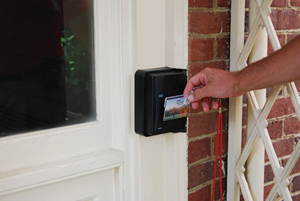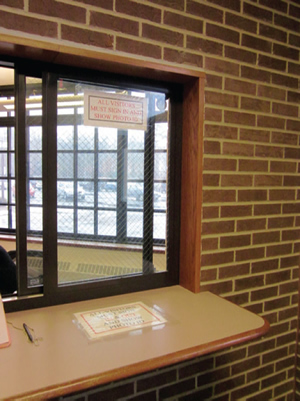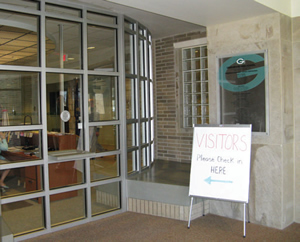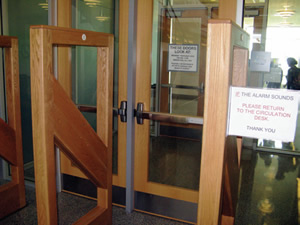Improving Access Control and Lockdown
- By April Dalton-Noblitt
- 02/01/15

PHOTOS COURTESY OF ALLEGIOIN
Access Control is the way an organization manages credentials and the access and egress of staff and visitors on a daily basis. In the event of an emergency, though, access control is not enough. Although this article cites schools in specific, the information covered is pertinent to any organization.
Beyond access control, every organization should have a lockdown strategy which determines the state of each opening of the building, both on demand or as soon as an emergency is detected. Effective lockdown strategies are defined by two critical aspects:
1. Security Zones.
Every facility can be broken down into unique security zones. Within each zone are openings that have unique requirements relative to the spaces they provide egress to and from in emergency situations.

PHOTOS COURTESY OF ALLEGIOIN
2. People and Processes.
An organization’s ability to activate lockdown is dependent on the method of access control and the role people play in that process. Protocol must be clearly established and regularly practiced.
Designing for each layer of security
Each layer has a set of needs that need to be implemented to assure the highest possible levels of security and safety during an incident.
Campus Perimeter. First of all, design landscaping so that shrubs, trees and other features do not get in the way of line-ofsight surveillance. As a corollary, ensure unobstructed surveillance of the main access points to the common area. Reduce the number of unmonitored building entrances and limit the number of entryways and exits to buildings throughout the campus. A common practice is to use fencing such as small mesh, chain link fencing that does not allow footholds. Ensure covered walkways will not provide intruders access to upper levels windows and roofs. Provide appropriate lighting for the parking areas.
Multi-Building Perimeter. Implement consistent credential management standards across multiple buildings on campus with pre-defined access roles that correlate with identified security zones.

PHOTOS COURTESY OF ALLEGIOIN
Single Building Perimeter – Exterior. Restrict access via the main entrance during school or business hours. Install a camera monitor that lets personnel view visitors prior to access and allows access only when appropriate. Create an entrance vestibule that forces visitors to be verified and checked in through the office. Install doors that facilitate immediate lockdown via electrified hardware or electronic hardware solutions. Use electronic access control for secondary entrances.
Single Building Perimeter – Assembly/Corridors. Equip doors to assembly spaces and corridors with panic hardware or fire exit hardware that lets doors be locked without entering or touring each opening. Consider electric latch retraction on doors to facilitate quicker lockdown. Use a door position switch that sends “alert” signals when doors are open. Employ a video system to monitor all external doors.
Individual rooms or classrooms. Specify locks that provide faster lockdown in the event of an emergency. There are several options. For instance, classroom security locks offer manual or remote fob locking capabilities so that a teacher can lock the outside lever without ever opening the door to the corridor but, at the same time, won’t restrict egress. Locks with indicators on the interior escutcheon will show at a glance which way to turn the key or provide visual status as to whether or not the door is locked. Networked controlled locks will provide immediate lockdown from a central point, such as the office. Where total building or facility lockdown is desired, electronic locks produce the fastest results. Don’t forget to equip non-egress doors connecting rooms with locks.
Lockdown procedures and preparations
Those in charge of lockdown procedures need to be aware of several things. Here is a very quick overview.
First of all, administrators need to designate an individual to call 911 and to stay on the phone with the operator. Also notify the district office as quickly as possible. They also need to notify all staff, students and visitors of the situation quickly via the intercom, bells or some other way throughout the facility, irrespective of what room they are in.
Regardless of what room people are in, shut and lock all doors and windows, pull draperies or close blinds and blacken any doorway windows. Never open the door for anyone or peek out windows until notified. Move everyone out of the line of sight, usually away from the windows. Have them stay low and keep quiet. Turn off the lights and silence electronics. Take roll and notify the office, if possible, of anyone missing.

PHOTOS COURTESY OF ALLEGIOIN
For short-term lockdowns, open the emergency supply box if needed. For longer lockdowns, open the emergency supply box and set up a latrine system. These boxes are a project in themselves. There needs to be a procedure of keeping emergency boxes fresh and how to distribute them. In schools, many keep such basics in each classroom. Others store caches in several different areas spread across the building. A plan is then needed to get them to other rooms.
Supplies on hand should include water, food, first aid equipment, individual student prescriptions, blankets, toilet supplies including a make-do toilet (often the pail that holds the rest of the supplies), duct tape, communications equipment and fire extinguishers.
Range of lockdown solutions
When it comes to securing a school or building, there is not a “one-size-fits-all” solution. The age of the facility, credential management platform and inherent protocols, budget and long-term security strategy must be considered. Based on all three factors, the next step is to determine if a manual, remote/local, centralized or combination will best suit the facility.
Manual Lockdown. Keys manually lock down a room or space. Manual lockdown relies completely upon an individual having the right credential in hand and being at the opening. The speed of the lockdown is dependent on how fast the staff member gets to the door to lock it. Manual lockdown is the least secure way to lockdown a building or room as it requires the greatest amount of staff accountability. However, it is also the least expensive lockdown option.
Remote/Local Lockdown. This method uses a standalone electronic lock solution that provides instant lockdown with a remote fob from up to 75 feet from the door. However, it still relies on multiple staff members. Nonetheless, it is easier and faster to implement than a manual lockdown. Its cost is mid-range.
Centralized Lockdown. This is the most secure option. It requires only a single point of accountability. Lockdown is activated via a computer or smartphone. It is also the fastest solution because one function simultaneously locks all openings on the network. The organization can retrofit locks easily in existing structures since there is no need for hardwiring at each opening. Of course, it is also at the highest cost point.
What to avoid
Select only door hardware that does not require an individual to step out of the room — possibly into harm’s way — to lock a door. Ideally, hardware options should be permanently attached the door, so that teachers or staff need not locate and attach the device in the midst of a lockdown emergency. Avoid hardware or other methods that offer an “unrestricted ability” to lock or unlock the door, allowing anyone, including students, to take control of the opening. Note that magnets or tape on the door to prevent latching not only offers unrestricted locking, but may also violate fire and life safety codes. In addition, door hardware that slows down egress or does not meet egress requirements should be avoided. Lastly, make it a proactive habit to keep classroom doors closed during the day and in a ready position for an emergency lockdown.
Emerging lockdown standards
National standards for school lockdown procedures are beginning to emerge. However, the responsibility of developing a lockdown policy continues to lie with individual facility administrators and security personnel. By design, an emergency lockdown procedure ensures that all internal and external doors and windows are locked or secured. Occupants inside the building(s) remain inside their secured rooms and await an “all clear” from emergency personnel.
This article originally appeared in the issue of .